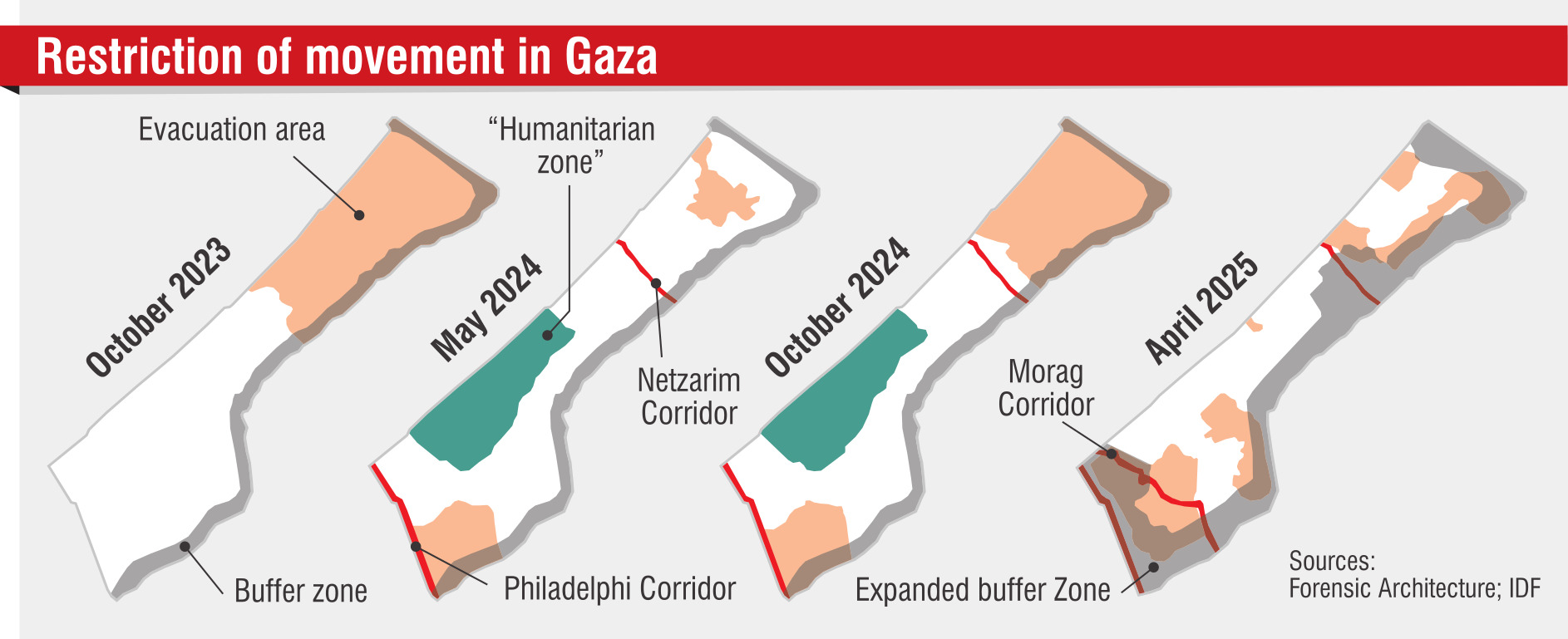
For Palestinians across the Gaza Strip, the past 19 months have been a dizzying and near-constant scramble for relative safety under bombardment. Now the Israeli army is preparing for its most intense offensive yet to squeeze Gaza’s entire population into a rapidly shrinking space; possibly forcing Gazans out of the strip altogether.
Throughout the war, Israel has systematically restricted Palestinians’ access to large parts of Gaza through scores of evacuation orders announced on army social media channels or in leaflets dropped from the sky. At times, residents have been allowed to return to their homes following Israeli ground manoeuvres aimed at crushing local Hamas battalions. But other areas have remained off-limits.
Of a total pre-war population of 2.2 million, an estimated 1.9 million Gazans have been forced to flee during the lengthy ground offensive, most of them many times over.
Israel has routinely emphasised that its operations in Gaza are intended to eliminate Hamas and free the hostages, of whom 59 remain in captivity. Yet its army has also seized large swathes of territory, razing thousands of structures to create military corridors that bisect the Strip and a buffer zone along its perimeter. Originally extending 1km into Gaza, the buffer zone has doubled in size and swallowed up an entire city since Israel unilaterally broke off the ceasefire in March.
For much of the war, Israel has directed fleeing Palestinians towards a 6.5sq km "humanitarian zone" in al-Mawasi — a narrow, sandy coastal strip in southern Gaza. Originally comprising just 3% of Gaza’s total area, this zone has expanded to accommodate more than 1million refugees living in tents. Despite designating it a safe zone, Israel reportedly bombed the area 97 times between May 2024 and January 2025.
Israel recently announced plans for a new ground offensive in Gaza as early as this week, pledging to permanently capture more territory and flatten what remains of Gaza’s buildings and infrastructure. Prime Minister Benjamin Netanyahu said the entire Palestinian population would be "moved for their safety" — reportedly to an area on the ruins of the city of Rafah near Gaza’s border with Egypt.
As Israel seizes more land and makes it increasingly uninhabitable, its leaders continue to advocate for the transfer of Gaza’s population (in line with Donald Trump’s "Riviera Plan"), facilitated by a newly established "voluntary emigration bureau" within Israel’s defence ministry.
October 2023
A week after the war began, Israel ordered 1.1 million Palestinians — half of Gaza’s population — to leave the north of the territory within 24 hours, before a ground invasion.
Soon after, the military imposed a buffer zone roughly 1km wide inside Gaza’s border, ostensibly to push threats away from Israeli communities. Measuring about 60sq km, it comprised more than 16% of the strip and 35% of Gaza’s agricultural land.
Before October 7, these areas were home to about 250,000 people. A report by the UN Satellite Centre found that, by April 2024, roughly 90% of the buildings within the buffer zone had been destroyed or damaged.
November 2023
After launching its invasion of Gaza, the Israeli army began occupying a 6km stretch of land that cuts across the middle of the territory, dividing the north from the south. The Netzarim corridor — named after a Jewish settlement that used to exist there — was quickly expanded to house a number of military bases used to monitor and control Palestinian movement.
Between September and November 2024, the army demolished more than 600 buildings in the surrounding area, expanding the corridor to about 50sq km of land. The Israeli newspaper Haaretz described Netzarim as a "kill zone" where Palestinians who entered would automatically be considered a terrorist and shot.
May 2024
Israel disregarded the Biden administration’s warnings that invading Rafah, a city close to Gaza’s southern border with Egypt, would cross a "red line". By then, Rafah had grown from a city of 280,000 people to a shelter for 1.4 million Palestinians who were fleeing bombardment elsewhere in Gaza. Israel’s incursion also displaced more than 900,000 people to the "humanitarian zone" in al-Mawasi.
October 2024
As Hamas battalions continued to regroup, the Israeli army adopted a new policy: forcibly displacing the entire civilian population from Gaza’s northernmost districts. In October 2024, the army issued evacuation orders for 400,000 Palestinians living in the north, telling them to go to al-Mawasi.
What became known as the "generals’ plan" involved severing these areas from the rest of Gaza, surrounding hospitals and denying aid entry. As Israel tightened its operation, the UN’s commissioner-general for Palestinian refugees, Philippe Lazzarini, warned that "people attempting to flee are getting killed, their bodies left on the street".
April-May 2025
After the ceasefire’s collapse in March, Netanyahu announced the seizure of another military corridor, this time dividing the cities of Khan Younis and Rafah in the south. It was named Morag after another Jewish settlement. The area contained some of Gaza’s last remaining agricultural land and water infrastructure.
The military also seized control of Rafah and its surrounding area after issuing new evacuation orders, absorbing an additional 20% of Gaza’s territory into the "buffer zone" and rendering the entire city inaccessible. Israeli security officials said the aim of the manoeuvre was to "permanently empty" the area.
Israel’s defence minister said the IDF were "dismembering the Gaza Strip" to put pressure on Hamas, while Netanayahu announced the army was "shifting gears" towards a continuous ground presence in Gaza, rather than targeted incursions and withdrawals. Already one of the world’s most densely populated areas, the UN has declared that 70% of Gaza is now inaccessible owing to the expanded "buffer zone" and new evacuation orders.














